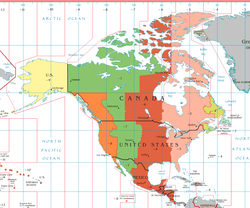Atlantic Time Zone

The Atlantic Standard Time Zone (AST) is a geographic region that keeps time by subtracting four hours from Greenwich Mean Time (GMT), resulting in GMT-5 (UTC-5). The clock time in this zone is based on the mean solar time of the 60th degree meridian west of the Greenwich Observatory.
In Canada, the provinces of New Brunswick, Prince Edward Island, Nova Scotia, and small portions of Quebec (eastern Côte-Nord and the Magdalen Islands) are part of the Atlantic Standard Time Zone. Officially, the entirety of Newfoundland and Labrador observes Newfoundland Standard Time,[1] but in practise Labrador uses the Atlantic Standard Time Zone.
Other parts of the world that keep time by subtracting four hours from UTC include Bermuda, in the North Atlantic; many Caribbean islands, including Puerto Rico, the US Virgin Islands; and several South American countries, such as Paraguay, Chile, Bolivia, and parts of Brazil. Venezuela used AST until December 9, 2007, when it switched to UTC-4:30.
AST is known (where applicable) as Atlantic Daylight Time (ADT) during daylight saving time, and has one hour added to make it three hours behind GMT (GMT-3).
Major metropolitan areas
- Asunción, Paraguay
- Bridgetown, Barbados
- Cape Breton Regional Municipality, Nova Scotia
- Charlotte Amalie, U.S. Virgin Islands
- Charlottetown, Prince Edward Island
- Concepción, Chile
- Fredericton, New Brunswick
- Georgetown, Guyana
- Halifax, Nova Scotia
- Hamilton, Bermuda
- La Paz, Bolivia
- Manaus, Brazil
- Moncton, New Brunswick
- Oranjestad, Aruba
- Port of Spain, Trinidad and Tobago
- Saint John, New Brunswick
- San Juan, Puerto Rico (no DST)
- Santa Cruz, Bolivia
- Santiago, Chile
- Santo Domingo, Dominican Republic
- Sucre, Bolivia
- Summerside, Prince Edward Island
- Willemstad, Netherlands Antilles
Sources
- World time zone map
- U.S. time zone map
- History of U.S. time zones and UTC conversion
- Canada time zone map
- Time zones for major world cities
- Official times across Canada
- The official U.S. time for the Atlantic Time Zone (no DST)
References
- ^ "RSNL1990 CHAPTER S-23 - STANDARD TIME ACT". Retrieved 2007-11-16.
